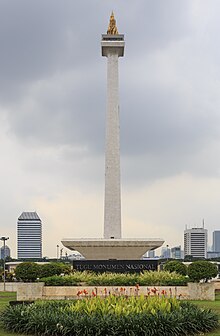National monument



A national monument is a monument constructed in order to commemorate something of importance to national heritage, such as a country's founding, independence, war, or the life and death of a historical figure. The term may also refer to a specific monument status, such as a national heritage site, by reason of their cultural importance rather than age). National monument status is usually granted to colossal symbols of national identity.
Overview
[edit]Structures or areas deemed to be of national importance and afforded protection by the state are part of a country's cultural heritage. These national heritage sites are often called something different per country and are listed by national conservation societies. Romania has listed at least one plant as a national monument, Nymphaea lotus bar. thermalis.[1]
Examples
[edit]
National monument
[edit]- Altare della Patria in Rome, Italy
- Maqam Echahid in Algiers, Algeria
- National Kaiser Wilhelm Monument in Berlin, Germany
- National Martyrs’ Memorial in Dhaka, Bangladesh
- National Monument in Jakarta, Indonesia
- National Monument in Kuala Lumpur, Malaysia
- National Monument in Amsterdam, Netherlands
- National Monument of Scotland in Edinburgh, Scotland
- Pakistan Monument in Islamabad, Pakistan
- Pobednik in Belgrade, Serbia
- Statue of Liberty in New York Harbor, United States
National heritage sites
[edit]- National heritage sites of South Africa
- National monuments of Colombia
- National monuments of Ireland
- National monuments of Portugal
- National monuments of Singapore
- National monuments of Spain
- National monument (United States)
See also
[edit]References
[edit]- ^ Veler, Ana (November 2008). "Nymphaea lotus up north, naturally". Water Gardeners International. 3 (4). Bucharest, Romania. Retrieved 9 August 2014.
